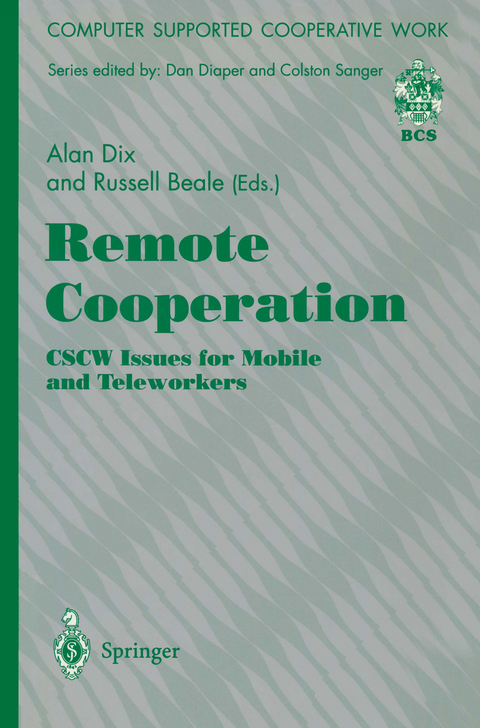
Remote Cooperation: CSCW Issues for Mobile and Teleworkers
Springer Berlin (Verlag)
978-3-540-76035-1 (ISBN)
Broadly divided into five sections - social and economic context, application domains, software technology and infrastructure, communications technology and infrastructure, working and learning from home - this volume contains contributions from both the research community and industry.
So Near Yet So Far.- The Structure of this Book.- Framing the Problem.- Future Directions and Further Information.- 1 Working in the Virtual Office.- 1.1 Introduction.- 1.2 Why Are People Working in Virtual Offices?.- 1.3 Technology for the Virtual Office.- 1.4 Advantages of Working in a Virtual Office.- 1.5 Disadvantages of Working in a Virtual Office.- 1.6 Addressing the Disadvantages of the Virtual Office.- 2 CSCW for the Mobile Teleworker.- 2.1 Introduction.- 2.2 How Telework Concepts Affect Field Based Mobile Workers.- 2.3 How Telework Concepts Affect Intrinsically Mobile Workers.- 2.4 The Basic Technology for Mobile Telework.- 2.5 The Role of CSCW.- 2.6 The Basic Technology of CSCW for Mobile Workers.- 2.7 The Interaction Between CSCW and Telework.- 2.8 Teamworking Across Enterprise Boundaries.- 3 The Electronic Hard Hat: CSCW on the Construction Site.- 3.1 Introduction.- 3.2 Review of Past Work.- 3.3 Available Technology.- 3.4 CSCW on the Construction Site: a Possible Scenario.- 3.5 The Electronic Hard Hat.- 3.6 Future Scenarios.- 3.7 Conclusion: A Plea to Communications Companies.- 4 Support for Community Care.- 4.1 Introduction.- 4.2 Community Health Services and Community Care Workers.- 4.3 Community Care Systems.- 4.4 The Field Trial of System B.- 4.5 Some Results of the Evaluation Exercise.- 4.6 Comparison with System A.- 4.7 Conclusion.- 5 The' salesman's Promise': CSCW in Sales.- 5.1 Introduction.- 5.2 The Cell Based Factory.- 5.3 Sales Scenarios.- 5.4 Product Advisor.- 5.5 Conclusions.- 6 Observations on Practically Perfect CSCW.- 6.1 Introduction.- 6.2 General Requirements.- 6.3 Toward Observational Properties.- 6.4 Using the Model.- 6.5 Toward Practically Perfect CSCW.- 6.6 Conclusions.- Acknowledgements.- 7 Personal Information Management in theContext of Collaborative Work.- 7.1 Introduction.- 7.2 Personal Information Management and the Representational Focus.- 7.3 Time Management: A Case for CSCW?.- 7.4 Personal Information Management and CSCW.- 8 Activity Coordination in Decentralized Working Environments.- 8.1 Introduction.- 8.2 Some Aspects of Activity Coordination.- 8.3 The Task Manager: An Example for Activity Coordination.- 8.4 Consistency in an Asynchronous Environment.- 8.5 Conflict Handling.- 8.6 Mobility and Activity Coordination.- 8.7 Summary.- 8.8 Outlook.- 9 Information Requirements of Distributed Workers.- 9.1 Introduction.- 9.2 Background - The Workers and the Technology.- 9.3 Principal Topics.- 9.4 Retrieval and Caching.- 9.5 Synchronization.- 9.6 Other Areas and Future Work.- 9.7 Summary.- 10 Mobile Open Systems Technology for the Utilities Industries.- 10.1 Introduction.- 10.2 Requirements of Mobile Utilities Workers.- 10.3 Integration Technologies.- 10.4 Mobile Computing Technologies.- 10.5 The Impact of Mobility on Distributed Systems Platforms.- 10.6 The MOST Approach.- 10.7 Concluding Remarks.- 11 The Distributed Home Environment and the New Oikos.- 11.1 Introduction.- 11.2 The Oikos Concept.- 11.3 The Distributed Home and Telework.- 11.4 The Homelink Project.- 11.5 Future Directions.- 11.6 Summary.- 12 Teaching, Learning and Collaborating at a Virtual Summer School.- 12.1 Introduction.- 12.2 Design Issues.- 12.3 Teaching and Learning at a VSS.- 12.4 Evaluation and Discussion.- 12.5 Discussion and Conclusions.- Appendix: A Detailed Profile of the VSS Students.- References.- Name Index.
| Erscheint lt. Verlag | 18.10.1996 |
|---|---|
| Reihe/Serie | Computer Supported Cooperative Work |
| Zusatzinfo | XV, 236 p. 30 illus. |
| Verlagsort | London |
| Sprache | englisch |
| Maße | 155 x 235 mm |
| Gewicht | 400 g |
| Themenwelt | Mathematik / Informatik ► Informatik ► Betriebssysteme / Server |
| Informatik ► Software Entwicklung ► User Interfaces (HCI) | |
| Mathematik / Informatik ► Mathematik ► Finanz- / Wirtschaftsmathematik | |
| Wirtschaft ► Betriebswirtschaft / Management ► Unternehmensführung / Management | |
| Schlagworte | CSCW • Design • Distributed Systems • Information Management • learning • Management • Manager • mobile computing • Modeling • organization • Usability |
| ISBN-10 | 3-540-76035-0 / 3540760350 |
| ISBN-13 | 978-3-540-76035-1 / 9783540760351 |
| Zustand | Neuware |
| Haben Sie eine Frage zum Produkt? |
aus dem Bereich


